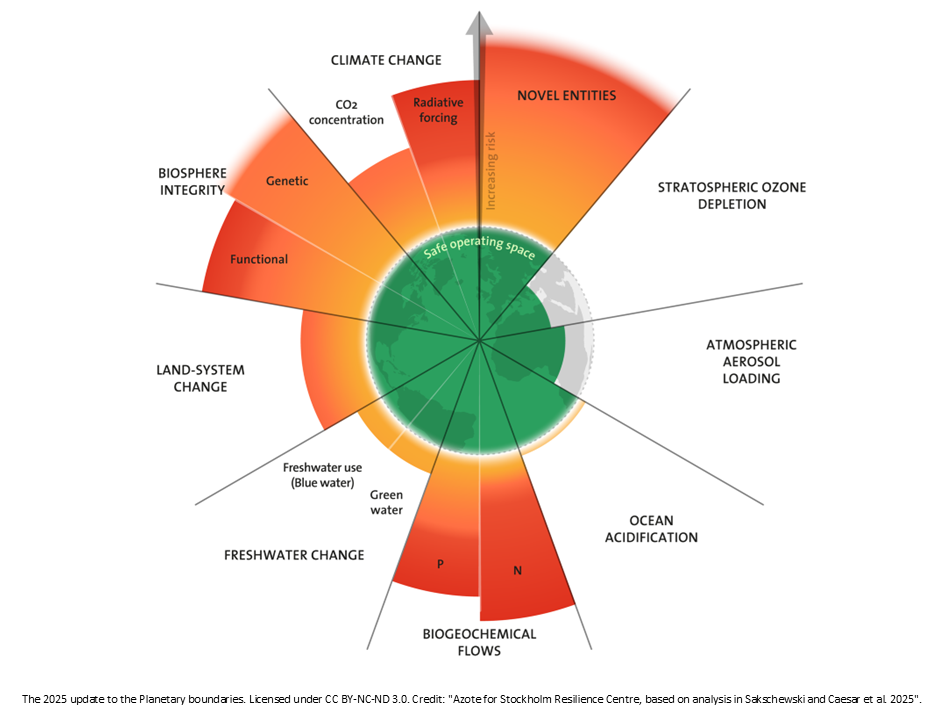Pick Up
1349. Planetary Health Check 2025

1349. Planetary Health Check 2025
We are entering the Anthropocene, an era in which human activity dominates the Earth system. By exceeding the limits of Earth's Safe Operating Space (SOS), human activity is weakening Earth's natural resilience, accelerating global warming, degrading ecosystems, and contributing to the emergence of tipping points in key systems. To protect Earth's resilience and stability, we must restore it to its planetary boundaries. These boundaries are scientifically defined guardrails that ensure the planet's health. Violating them risks irreversible damage to our own life support systems.
The Planetary Health Check 2025 focuses specifically on the ocean's role in the Earth system and, for the first time, assesses ocean acidification as the seventh boundary to be exceeded. The seven breached planetary boundaries are: Climate Change, Biosphere Integrity, Land System Change, Freshwater Use, Biogeochemical Flows, Novel Entities, and Ocean Acidification (new in 2025). All of these seven boundaries show worsening trends. Only Ozone Depletion and Aerosol Loading remain in the safe zone.
Climate Change
Earth's climate is in the danger zone. Greenhouse gas concentrations have reached record levels, global warming appears to be accelerating, and the situation continues to worsen. Atmospheric CO₂ concentrations will reach 423 ppm by 2025, far exceeding the Holocene baseline of 350 ppm.
Key drivers: fossil fuel combustion, processes leading to non-CO₂ greenhouse gas emissions, land system change, changes in biosphere health, and increasing atmospheric aerosol load.
Change in Biosphere Integrity
Natural safety nets are collapsing, with extinctions and losses of natural productivity far exceeding safe levels and showing no signs of improvement. The extinction rate remains above 100 E/MSY (extinctions per million species-year, or E/MSY), far exceeding the global limit of 10 E/MSY.
Key drivers: biomass extraction (agriculture, forestry, and fishing), invasive species introductions, land system change, climate change, changes in freshwater resources, changes in biogeochemical flows, introduction of novel organisms, and ocean acidification.
Land System Change
Global forests are shrinking, with most already below safe levels. While the overall trend is still worsening, the pace of deforestation is slowing. Global forest cover has fallen to approximately 59%, well below the minimum safe level of 75%. Key drivers: expansion of agricultural land and livestock grazing, logging, expansion of settlements and infrastructure, climate change, desalination, and biosphere health.
Freshwater Change
Human impacts on rivers and soil moisture are expanding, further undermining the stability of water systems and increasing the risk of droughts and floods. More than one-fifth of the world's land area currently faces significant dry or wet deviations in river flow (22.6%) and soil moisture (22.0%), approximately twice pre-industrial baselines and far exceeding safe levels (12.9% and 12.4%).
Key drivers: irrigation and agriculture, industrial water use, domestic water use, climate change, increasing atmospheric aerosol loads, and land system changes.
Modification of Biogeochemical Flows
Excessive fertilizer use has led to excessive accumulation of nitrogen and phosphorus in land and water, creating pollution and dead zones with no signs of improvement. Phosphorus application rates are approximately 18.2 Tg P/yr (three times the planetary boundary), and nitrogen fixation rates are approximately 165 Tg N/yr (more than twice the planetary boundary), placing us in the high-risk zone and showing a worsening trend.
Key drivers: Application of mined mineral phosphorus as fertilizer to fields, application of industrially fixed nitrogen as fertilizer to fields, and cultivation of nitrogen-fixing crops.
Ocean Acidification
The oceans are becoming increasingly acidic, threatening marine life. The Earth's mean surface aragonite saturation (Ω) is currently 2.84, slightly below the revised planetary boundary of 2.86 (equivalent to 80% of the newly updated pre-industrial Ω). This marks the first time that the planetary boundary for ocean acidification has been assessed as having been exceeded.
Key driver: Fossil fuel combustion.
Increase in Atmospheric Aerosol Loading
Inter-hemispheric air pollution differences are narrowing. This is a positive sign that global air quality is gradually improving.
Key Contributors: Fossil fuel burning, biomass burning,
Stratospheric Ozone Depletion
The ozone layer is stable and showing signs of slow recovery, maintaining its protection from harmful UV rays. Recovery under the Montreal Protocol continues, although ozone remains below historic levels and the Antarctic ozone hole remains.
Key Contributors: Production and emissions of ozone-depleting substances such as synthetic chlorofluorocarbons (CFCs) and nitrous oxide (N2O).
Introduction of Novel Entities
The use of man-made chemicals, plastics, and other new substances continues to increase without adequate testing or controls, posing growing environmental risks.
Key Contributors: Industrial production of man-made chemicals for industry, agriculture, and consumer goods.
“We are witnessing a widespread decline in the health of our planet. But this is not an inevitable outcome. The drop in aerosol pollution and healing of the ozone layer show that it is possible to turn the direction of global development. Even if the diagnosis is dire, the window of cure is still open. Failure is not inevitable; failure is a choice. A choice that must and can be avoided,” said Johan Rockström, Director of the Potsdam Institute for Climate Impact Research, and researcher at the Stockholm Resilience Centre.
(Reference)
Sakschewski, B., … Rockström, J. (2025): Planetary Health Check 2025: A Scientific Assessment of the State of the Planet, Potsdam: Potsdam Institute for Climate Impact Research (PIK), 144 p.
https://doi.org/10.48485/pik.2025.017, Cite as: https://publications.pik-potsdam.de/pubman/item/item_32589
Contributor: IIYAMA Miyuki, Information Program
